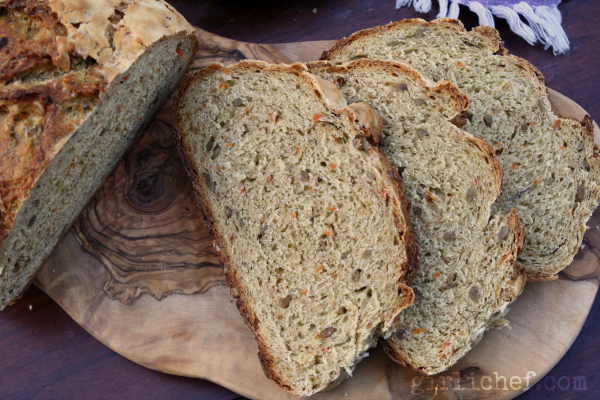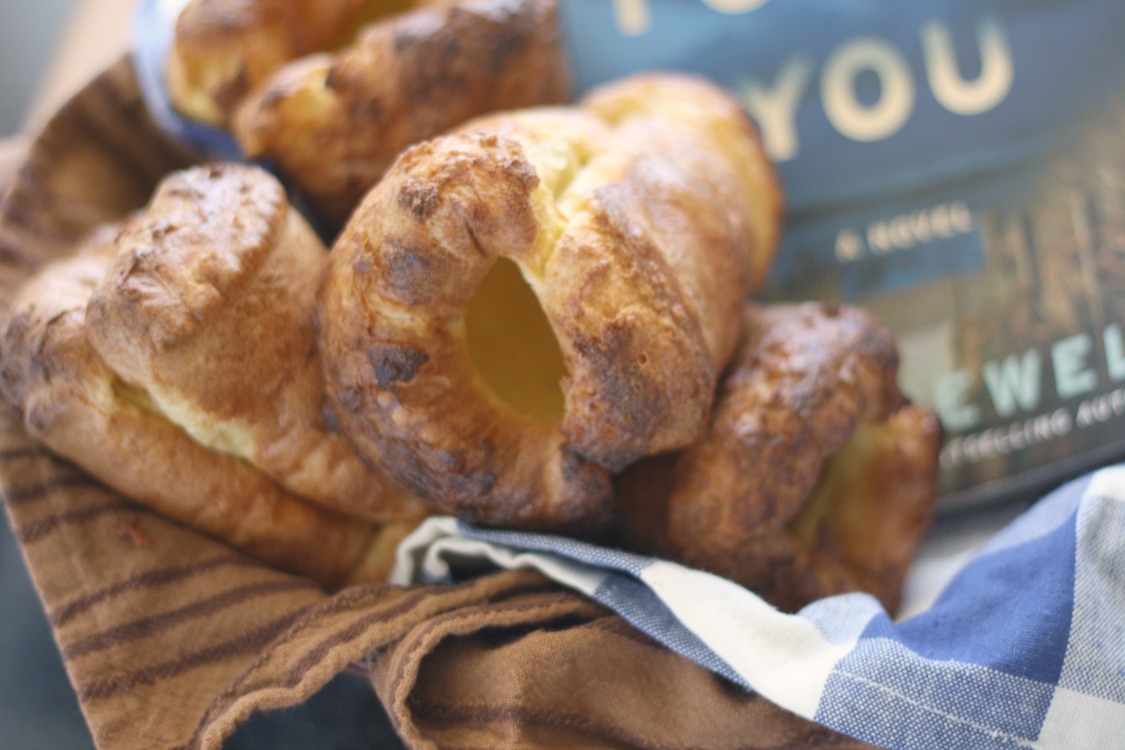I wanted something that was a bit of a challenge. It wasn't difficult, but it wasn't just a knead, rise, and go dough, either. Here are the variables that go into these loaves:
- extra steps: making a poolish and a glaze
- different types of flour: rye, bread, rice
- a (possibly) difficult to find ingredient: carrot juice
- add-ins: grated carrots, chopped parsley, sunflower seeds, sesame seeds
Plus, it makes a large batch; 3 loaves to be exact. And straight-up, the dough is a bit of a wild child. All the Babes (as far as I know), needed more water than called for in the poolish. Myself included. Don't be frustrated if you make this - drizzle and stir until you get a good consistency.
The final dough is a bit stiff, but oddly enough, I had a fun time shaping it. My recommendation? Let it rest a little longer between forming into a ball, and forming it into a cylinder. Dough likes to relax, too.
I hope that I haven't scared you off, because the toils are worth the spoils. Sliced and added to a bread basket, this would be the first to be snatched up. It's fantastic alongside soup. It makes brilliant toast, and a very fine grilled cheese sandwich. And after all, a bit of a challenge is good for you. It hones skills and builds confidence.
I hope you'll go visiting to see how the rest of the Babes fared. Most of all, I hope that you'll bake along as a BBBuddy this month!
Carrot Bread
by
Prep Time: 28 hours (mostly unattended)
Cook Time: 45 minutes
Keywords: bake bread vegan dairy-free soy-free carrots flour
Ingredients (3 loaves)
- 3/4 teaspoon active dry yeast
- 1 cup lukewarm water + more as needed
- 2-1/2 cups (13 ounces / 364 grams) stone ground rye flour
- 1/3 cup toasted sesame seeds
- 3/4 cup toasted sunflower seeds
- 2-1/2 teaspoons active dry yeast
- 1 cup carrot juice, lukewarm
- 1-1/4 cups grated carrot
- 1/2 cup chopped parsley
- 6-6-1/2 cups (29.4-31.8 ounces / 823.2-890.4 grams) bread flour
- 2 tablespoons + 1 teaspoon golden syrup (or honey or maple syrup)
- 1/4 cup sunflower oil
- 4 teaspoons sea salt
- 1 teaspoon active dry yeast
- 3/4 cup + 2 tablespoons lukewarm water
- 3/4 cup + 1-1/4 tablespoons (4.7 ounce / 131.6 gram) rice flour
- 2 teaspoons sugar
- 1-3/4 teaspoons sunflower oil
- 3/4 teaspoons sea salt
Instructions
Day 1: Make the PoolishDissolve the yeast in the water, and let sit a few minutes to bloom. Whisk in the flour until smooth - if it is very thick, continue whisking in more water until it is the consistency of a thick batter. Cover with plastic wrap and let sit at room temperature for 24 hours; at this point it should be a bit bubbly.
In a large bowl (or bowl of a stand mixer fitted with dough hook attachment), dissolve the yeast in the carrot juice, let sit a few minutes until it looks creamy (bloomed). Add the grated carrot, parsley, the lesser amount of bread flour, golden syrup, and the poolish to the bowl. Knead on low speed for 3 minutes. If the dough doesn't seem too sticky, then don't add any more of the flour; it will firm up as it is kneaded (plus you have more to add to it).
Add the oil to the bowl and knead for another 8 minutes. Add the salt, increase the speed, and knead until elastic, about 7 more minutes. At this point, the dough will not be sticky any longer. Use the extra flour, a tiny bit at a time, to remedy the dough if it is. Add the toasted seeds, and gently mix in.
Place the dough into a large, lightly oiled bowl or container and cover. Let sit for 60-90 minutes, *knocking the dough back halfway through. To knock the dough back, remove it from the bowl and set it on a work surface. Use your hands to knock the air out of it. Fold the edges towards the center to form a cushion. Replace in the container, seam side down.
make the Crackling Glaze:While the dough is rising, dissolve the yeast in the water in a medium bowl. Whisk in the remaining ingredients. It should be spreadable, but not runny. Cover with plastic wrap and allow to sit for at least 30 minutes before using.
Turn the dough out onto a lighty floured work surface and divide into 3 equal parts (approximately 78 ounces of dough to equal three 26 ounce portions).
Form the portions into three round balls, and cover them with a clean tea towel. Let rest for 10 minutes.
Shape each circle of dough into an oblong loaf, by gently pressing ball down into a circle and then tucking/rolling into shape. Set loaves, seam side down, onto a lightly floured bread peel or thin cutting board. Glaze the loaves generously with the crackling glaze (you'll have a lot of leftover glaze), and leave to rise at room temperature for 60-75 minutes, or until the dough has doubled in size and the the surface is crackled.
Place a baking stone into the oven, and preheat to 475° F during last 20 minutes or so of rise time.
Slide the loaves onto the stone (let them rise directly on a baking sheet or two if you don't have a stone - slide that into preheated oven) and spray generously with water. Close oven door. Lower the temperature to 400° F after 5 minutes. After another 10 minutes, open the oven door to let in a little air. Repeat two more times (every 10 minutes). Total baking time will be 45 minutes.
Remove bread from oven and cool on a wire rack.
These loaves are fantastic sliced up and shared in a bread basket, or served alongside a soup and salad. They also make great toast (slathered with salted butter) and sandwiches. My breakfast for a week was thickly sliced piece of toasted Carrot Bread, with salted butter, a thin slice of smoked ham, and a few shards of strong cheese.
Remember, if making this vegan, do NOT use honey as your sweetener.
Remember, if making this vegan, do NOT use honey as your sweetener.
Knocking back is normally done only with wheat doughs. Acetic acid is formed between 36° F and 75° F, which slows down the fermenting process. Knocking the air out evaporates most of the acetic acid, but what remains together with the softer lactic acid forms that great aromatic smell. The traditional cushion shape makes the dough more pliable, and the temperature ensures stability and provides the yeast cells with new nourishment. The removal of carbon dioxide from the dough flavors fermenting, the yeast propagates, the gas bubbles increase in number and the dough rises more quickly. By knocking back the bread you get a larger bread, which is easier to handle and which has a better and more elastic interior. (source: Artisan Breads by Jan Hedh)
adapted from Artisan Breads: Practical Recipes and Detailed Instructions for Baking the World's Finest Loaves by Jan Hedh
The Bread Baking Babes are: Bake My Day - Karen | blog from OUR kitchen - Elizabeth | Feeding my Enthusiasms - Pat/Elle | girlichef - Heather | Life's a Feast - Jamie | Living in the Kitchen with Puppies - Natashya | Lucullian Delights - Ilva | My Kitchen In Half Cups - Tanna | Notitie Van Lien - Lien | Paulchen's Foodblog - Astrid | Provecho Peru - Gretchen | Thyme for Cooking - Katie (Bitchin’ Bread Baking Babe Bibliothécaire)
The Bread Baking Buddies are: YOU!
Since I am the hosting Babe kitchen of the month, if you'd like to join in, simply bake this Carrot Bread (yes, you may adapt) - and then send me a link to your post via email (girlichef at yahoo dot com) or leave it in the comments section of this post. Submissions are due by October 29th. Once you've posted, I'll send you a Buddy badge for baking along. I hope you'll join us this month!
The Bread Baking Buddies are: YOU!
Since I am the hosting Babe kitchen of the month, if you'd like to join in, simply bake this Carrot Bread (yes, you may adapt) - and then send me a link to your post via email (girlichef at yahoo dot com) or leave it in the comments section of this post. Submissions are due by October 29th. Once you've posted, I'll send you a Buddy badge for baking along. I hope you'll join us this month!
I am sharing these loaves with:
Yeastspotting
BYOB - Il Cestino del Pane








.png)



